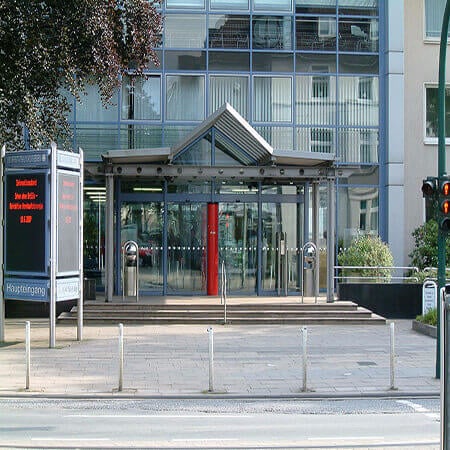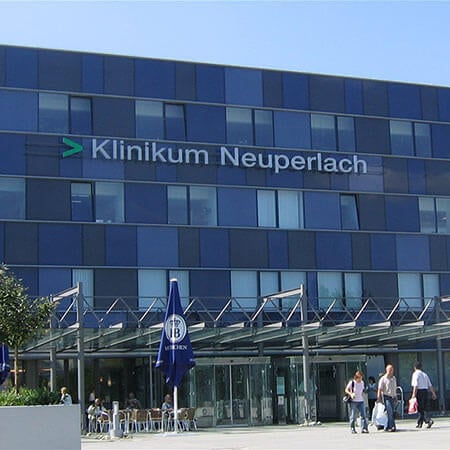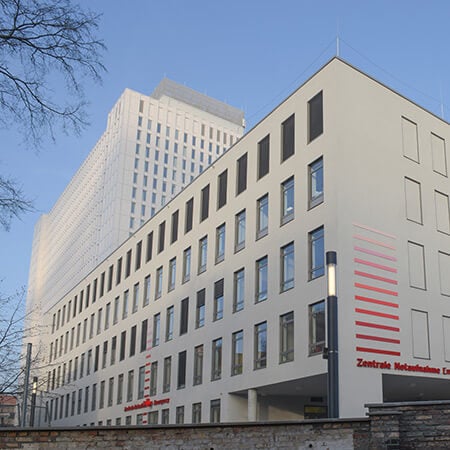Myocardial infarction
Due to the difficulties associated with the organization of treatment in Turkey, Switzerland, South Korea and India, we are not currently processing requests to these regions.
If you are interested in treatment in Germany, please leave a request and our specialists will contact you as soon as possible.
According to WHO, the CIS countries take a leading place regarding the level of mortality from cardiovascular pathologies, including myocardial infarction. While in developed European countries the mortality rate from these diseases has decreased by 1/3 for the last 25 years. In the CIS countries, the cardiovascular mortality rate remains high. Currently, it is 3 times higher than the average European value. Timely provision of highly qualified medical care and effective supportive treatment help to cope with the consequences of a heart attack and return a patient to active life.
The Booking Health portal presents 72 German clinics specializing in myocardial infarction (heart attack) treatment
Show all clinics
Diagnostics of Myocardial infarction
The clinical picture of myocardial infarction is highly variable. The most common symptom is the chest pain. It occurs in 70-90% of cases according to different authors’ information.
Depending on the pain localization, there are several forms of myocardial infarction, such as:
- Typical form – chest pain
- Atypical form – abdominal pain
- Combined form – abdominal and chest pain
- Painless form – there is no pain syndrome (more common for patients with diabetes mellitus and those who have already had a heart attack)
Myocardial infarction often occurs due to the physical activity. The same factor contributes to the increasing or the occurrence of pain.
Additional symptoms that may accompany a pain syndrome in various forms of the disease:
- Nausea and vomiting, bloating
- Impaired consciousness
- Psychoemotional exaltation, fear
- Weakness
- Sweating
- Fast or slow pulse
- Dyspnea, cough with frothy sputum
All of these symptoms are not pathognomonic. They also can accompany other pathologies, therefore, to confirm the diagnosis the additional examinations are required, such as: ECG, ultrasound examination and biochemical tests (blood tests for cardiotropic proteins).
First aid of Myocardial infarction
If someone in your family has symptoms of the heart attack, the sequence of the actions should be as follows:
- Call an ambulance.
- Seat the patient in a chair, take off his shirt, tie and other clothing items that may make breathing difficult.
- Take all necessary measures to calm the person dawn, because stress contributes to a spasm of the coronary vessels, and it only aggravates the situation.
- Give a nitroglycerin pill.
- Give 300-500 mg of acetylsalicylic acid. In order to speed up the absorption of the drug, the patient should chew the pill.
Treatment for myocardial infarction
Emergency myocardial infarction therapy starts right after the arrival of an ambulance. It involves the administration of the following drugs:
- Clopidogrel
- Nitroglycerin
- Morphine in case of severe pain syndrome
- Thrombolysis (sometimes performed even during the pre-hospital phase)
A person is admitted to the department of cardiology. At the initial stage of therapy, the most important is the restoration of blood flow through the blocked blood vessel in order to stop the die-off of viable myocardium areas. Balloon angioplasty or pharmacological thrombolysis is often performed for this purpose.
Invasive methods are the most effective options of myocardial infarction treatment
- Coronary angioplasty and stenting. The balloon is inserted into coronary vessel. It is inflated with air and expands the artery. As a result, the blood supply to the heart is restored. An important addition to this method is stenting. Stent is a frame inserted into the coronary artery. It reduces the risk of restenosis (recurrent narrowing of the vessel lumen).
- Coronary artery bypass grafting (CABG) is more effective surgery that helps to restore blood flow, even in cases where balloon angioplasty fails. Shunts are an alternative path for the blood. A surgeon forms them using the fragments of arteries located in other areas of the patient's body. As a result, blood flows to the myocardium through other vessels that are not blocked by atherosclerotic plaques.
- Implantation of a cardioverter-defibrillator is used for many heart diseases, including the elimination of myocardial infarction consequences. As a result of this illness the rhythm and conduction disturbances of the heart muscle often occur. This is associated with the heart areas necrosis. For the same reason, the ejection fraction is reduced and indicates that the myocardium doesn’t fully perform its pumping function. The cardioverter-defibrillator implantation helps to normalize the rhythm, to improve patient’s quality of life and life expectancy.
- Cardiac rehabilitation is the complex of measures (medical, hygiene, sanatorium, cardiac surgery) that is required for restoration of the patient's quality of life after myocardial infarction. Their volume depends on the particular clinical situation.
Innovative treatment for myocardial infarction
Stem cells therapy (SC). This myocardial infarction treatment method helps to avoid connective tissue scars on the heart surface. The scar is namely the main cause of the myocardial conduction and contractility violations.
The essence of this method is the injection into the patient’s body of his own or donor stem cells, which are able to differentiate eventually into myocytes and replace the areas of necrosis. Chitosan hydrogel or another carrier, on which the stem cells are already placed, delivers them to the affected area. Upon reaching the destination, this jelly-like mass "is mounted" into the affected area and forms a porous frame, helping to stop the progression of necrosis.
The process of the substance injection via catheter is minimally invasive. Stem cells therapy can simultaneously localize the zone of necrosis and start recovery of the muscle cells in this area in a short time.
Laser revascularization is one of the methods for the rapid restoration of coronary vascular patency and renewal of normal blood circulation, which is carried out with the help of laser machine. The procedure involves a front or side chest wall incision with injection of a special electrode to the heart. The electrode makes pinholes in the myocard that are supposed to become a place of new micro-vessels formation. Thus, an artificial collaterals system is created, which takes charge of the blood supply of the affected heart site and provide normal metabolic processes in all its areas. The result of this treatment will be a significant improvement of the patient’s quality of life.
Best clinics for the myocardial infarction treatment in Germany:

University Hospital Essen
43310.5639126.56


Charite University Hospital Berlin
Myocardial infarction – Rehabilitation Rehabilitation after Myocardial infarction
Cardiological rehabilitation improves the quality of life in patients with cardiovascular diseases. It increases the effectiveness of maintenance treatment in the case of chronic cardiovascular diseases, and also facilitates recovery after exacerbations. Rehabilitation is extremely important in case of cardiac surgical interventions.
Cardiological rehabilitation has the following aims:
- Restoration of heart muscle normal function
- Elimination of symptoms (for example, chest pain, dyspnea, etc.)
- Improving working capacity and providing patient with the opportunity to return to previous professional activities
- Improving physical stamina
- Prevention of exacerbations (including elimination of the risk factors)
- Consulting the patient on self-control and basic principles of self-help
- Improving patient's mental state, ability to "live with the disease"
Effective cardiological rehabilitation is performed only in countries with the developed medicine, as innovative medications, appropriate medical equipment and qualified healthcare professionals are available only there. Basic methods of cardiological rehabilitation include:
- Drug support for normalization of blood pressure, blood clotting, cholesterol level
- Dosed physical exercises under the supervision of an instructor, with a gradual increase in intensity
- Physiotherapy (darsonvalization, electrophoresis with medications, electrosleep, laser and magnetotherapy)
- Relaxing techniques (massage, aromatherapy, acupuncture, psychotherapy)
- Dietotherapy (control of salt and liquid amount, using spices, etc.)
- Modification of lifestyle (smoking cessation, body weight normalization)
In Germany, cardiological rehabilitation undergoes under the constant control of cardiologists, therapists and rehabilitation specialists. Programs are designed for 2 weeks. If necessary, they can last much longer. In this country, the patient is provided with qualitative care, accommodation in comfortable rooms and individually selected meals.
Rehabilitation programs in Germany show one of the best results in the world. Most patients successfully restore their working capacity and excellent health there. They remain physically active, return to the full social and family life.
Best clinics for cardiac rehabilitation in Germany:
Author:
The article was edited by medical expert, board certified Dr. Nadezhda Ivanisova. For the treatment of the conditions referred to in the article you must consult a doctor; the information in the article is not intended for self-medication!
Sources:
ECR - European Cardiology Review
American College of Cardiology
The cost of services includes
Here you can find the cost of treatment for this disease at the German University Hospitals. Leave a request and we will provide a free consultation with a doctor and will start organizing the whole treatment process.
The program includes the following:
- Issuing of an invitation for getting a visa for treatment as quick as possible
- Fixing an appointment at a time convenient for you
- Preliminary organization of a comprehensive examination and discussion of the forthcoming treatment plan
- Arranging transfer from the airport to the hospital and back to the airport
- Provision of interpreting services and services of a personal medical coordinator
- If necessary, assistance in the organization of further surgical treatment
- Provision of a medical insurance against treatment complications covering up to 200,000 euro
- Preparation and translation of medical records and recommendations from the hospital
- Assistance in the subsequent communication with your attending physician, including consultations on repeated X-ray images through the unique medical document management system E-doc


